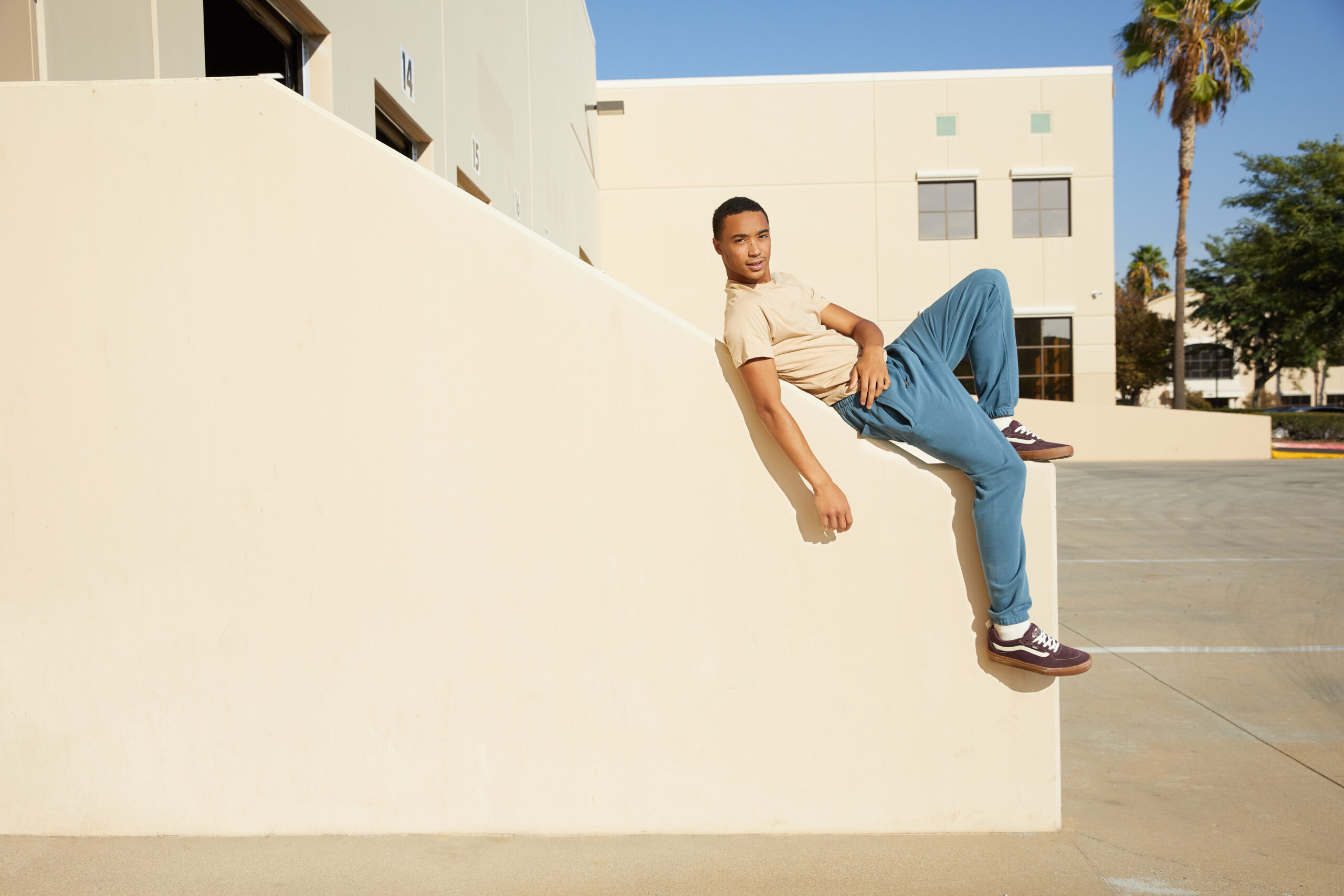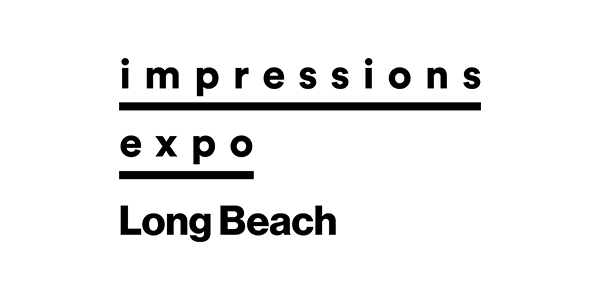If the basic T-shirt for 2025 has any dominant descriptors, they would be: “oversized” and “relaxed,” both of which derive in part from “’90s streetwear,” another 2025 trend for tees. Another is “heavyweight” or at least, “heavier weight.” Other buzzwords that encapsulate anticipated 2025 T-shirt trends are “sustainable, boxy and neutral.”
A selection of representatives from apparel companies weighed in on upcoming trends, including Marcus Davis, product manager with Hanesbrands, who said, “Tees are expected to continue to follow the macro trends that we’ve been seeing in recent years, such as designs inspired by the ’90s or materials focused on sustainability. Probably one of the fastest growing segments in the market are tees made with heavyweight fabrics, which I would categorize as being six ounces or heavier.”
Jen Oleksik, vice president of apparel for LAT Apparel, elaborated, “The basic tee will continue to be defined by fit, fabric, and quality. With so many options in the market, it is important to stand out with key differentiators. A consistent and well-fitting tee is a must. Fabric should not only be soft but also decorate easily. Quality encompasses the other two key factors, but also includes construction details, durability of the product, consistency of color and beyond.”
Milissa Gibson, sales director with Lane Seven Apparel, pointed to the merging of T-shirt categories in recent years. “For the last 15-20 years, the basic tee has fallen into one of two categories—a fashion basic and a staple commodity price-point-driven tee. Now, what was once considered fashion is becoming more in that commodity basic. You’re seeing the transition go from a lightweight to heavyweight,” she said.
“People will look for timeless pieces that easily fit into their everyday lives and don’t add to waste. Expect terms like conscious consumption, carbon-neutral, and eco-innovation to dominate the conversation,” added Katy Mendoza, creative director at Threadfast Apparel.

The Beefy Tee (5180R) has set the standard for more than 45 years. Photo courtesy of Hanes
Weight and See: Heavyweight T-shirts in Vogue
Virtually everyone who chimed in said that heavyweight T-shirts are coming back into vogue. “We’ve been seeing increasing focus on the “heavy tee” as being a new standard of ‘dressed up casual,’ and it makes sense,” says Ryan Zaczynski, founder and CEO of Maison Tiet Ltd. “Super thin tees, while comfortable, often lack durability and honestly aren’t very forgiving on many body types. Having a bit more weight to the material helps with durability, and with the right cut it has a more forgiving drape.”
Oleksik agreed about the heavier-weight fabrics, adding that they are emerging from the streetwear influence.
“The Hanes Beefy-T was actually at the start of this trend in 1975 when it was introduced as the first heavyweight tee in the print wear market. The recent attention to these heavier weight tees is fitting as the Beefy-T will be celebrating its 50th anniversary in 2025,” Davis said.
Comfort is King: Silhouettes and Fabrics/Fabric Blends
Whether it’s an after-effect of the pandemic or a subconscious need to be and feel comfortable due to the stresses of life, casual styles are trending toward “relaxed,” a holdover from previous years; a trend that began in the women’s market but is making its way to the men’s and youth markets, Oleksik noted, with boxier and cropped cuts still influencing the market.
Victoria Novosel, director of marketing at Bella+Canvas, agreed, adding, “Streetwear and cropped or fitted women’s silhouettes are still seen everywhere at retail, so we do expect that trend to continue into the wholesale market.”
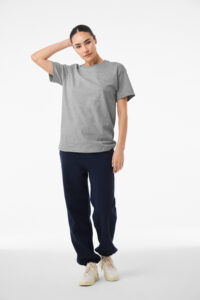
The Unisex Heavyweight Tee (4610) in Athletic Heather. Photo courtesy of BELLA+CANVAS
Oversized tees also continue to be in strong demand. Oversized fits, like relaxed fits, are all elements of what is comfortable. “It’s tough to go back to garments that might not be as loose and comfortable simply for the sake of fashion,” said Zaczynski. “Styling our oversized Cali Relaxed fit with outfits that go beyond sweats or jeans is something that has been cool to see. You wouldn’t think an oversized tee would be a likely pairing with a maxi skirt, but one of our customers on TikTok has made this look part of their regular rotation!”
Zaczynski is banking on the next generation of consumers that will come to support and understand the quality and value of hemp, despite the misperception that hemp is a rough and scratchy material. “Hemp textiles are almost always offered as a blend, so it will never displace cotton. Hemp blended with cotton or poly yarn produces unbelievably comfy, breathable knits that will wear well for years due to hemp’s exceptional durability, and it’s our mission to get this information out into the world,” he said.
One of the reasons that oversized and relaxed fits are popular is that they allow for layering. “Styles influenced by the ’90s will continue but expect classic silhouettes to be the biggest winners as consumers are looking for longevity in what they are wearing as a value for their money. Classic short sleeve and long sleeve tees will always be a staple to many people. Fast fashion items are no longer as popular due to how quickly they look dated,” said Marcus.
“In 2025, relaxed fits and drop shoulders will continue to dominate across men’s, women’s, and youth styles, driven by the streetwear and athleisure trends. Oversized silhouettes and boxy tees will remain essential for their comfort and versatility, with crop tops still trending among younger audiences,” said Mendoza.
What Goes Around Comes Around with Blank T-shirt Styles
T-shirt styles will be going up a notch, with the basic tee having a place in fashion and the ’90s increasingly back in vogue.
There is also a continued place for vintage looks, such as LAT Apparel’s introduction of its Vintage Wash collection, a trend that is not expected to wane any time soon.
“Society continues to look to the past to inform the present and inspire the future. In recent years our use of ‘vintage’ has been in reference to silhouettes and cuts of different products, but as we move into 2025, we’re seeing an even deeper influence in ‘vintage’ color. So maybe it’s a more modern silhouette with a worn or vintage look due to the way the product is dyed or the shade of the color standard,” said Novosel of her company’s perspective on vintage.
Influences: How T-shirts Got where they are Today
As in previous years, T-shirt design is influenced by many demographics and styles, but with the advent of social media and its ability to reach wider
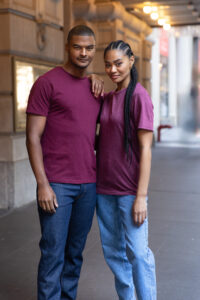
The Epic Unisex Tee (T1000) shown in Maroon Heather. Photo courtesy of Threadfast Apparel
audiences, fashion in general has become more universal. “Specifically in the ladies’ category, women are finding more confidence and excitement in wearing what they love no matter their size, shape, or age,” said Oleksik. “Online consumers are greatly driving new development, especially from a fit standpoint. More consumers than ever are purchasing apparel online. By offering a fit that is consistent, thoughtful and on-trend, it limits the number of returns and gives buyers confidence in the product purchase.”
For her part, Gibson said that the demographics that are having the most influence on T-shirt design and style is skewing younger and younger. By way of example, she said, “You’re seeing oversized, boxy fits trend at retail that are driven by the younger, Millennial Gen X, and you’re starting to see Gen Alpha’s influence on the fit.”
Most manufacturers agreed that streetwear is still a major influence on T-shirt styles, a resurrection from the ’90s, and accounts for the relaxed and oversized fits seen today.
“Streetwear has an influence on every generation, and we don’t anticipate that letting up,” said Zaczynski. “But we do hear whispers about streetwear fashion finally becoming a bit fatigued with the standard uniform of jersey knits and fleece—button up oxfords and other preppier garments are something we think will get an increasing amount of play in the coming seasons.”
Sustainability: Apparel Decorators and Customers Crave Eco-Friendly
Customers are seeking transparency in what they consume and what they wear, from where materials are sourced to how and where garments are being manufactured. While sustainability may have been a newfangled idea some years ago, many of today’s consumers are practically demanding it, and manufacturers are responding. The wholesale channel is gradually catching up.
“I believe the industry is doing what it can to address concerns around, not just environmental issues, but also those of corporate responsibility,” said Novosel. “Bella+Canvas has an internal committee that meets regularly to ensure we continue to push these boundaries and efforts.”
Likewise, Threadfast has developed initiatives like Better Cotton membership, U.S.-grown cotton sourcing and recycled polyester. “Through our Plant with Threadfast program, we plant a tree for every case sold, helping offset our carbon footprint and support communities impacted by forest fires,” said Mendoza. “That said, there’s more room to grow. We need to see wider adoption of certifications like WRAP and OEKO-TEX to meet evolving consumer expectations.”
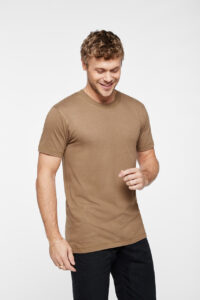
The Unisex Bamboo Tee has a soft feel. Photo courtesy of LAT Apparel
LAT Apparel has two new styles for 2025 that are environmentally friendly: first, its 6901ECO is a blend of 60-percent Combed Ringspun Organic Cotton and 40-percent Post-Consumer Recycled Polyester; second, the 6904 uses 70-percent Viscose from Bamboo and 30-percent Combed Ringspun Organic Cotton. “Bamboo-derived fabric is not only incredibly soft and comfortable to wear but also sustainably grown, making it a responsibly sourced choice,” said Oleksik.
Hanes also offers Hanes EcoSmart polyester, part of the Hanes EcoSmart cotton and polyester blended tees and in the Hanes Perfect Tri-Blend tees collections. “EcoSmart polyester is a technology that allows synthetic plastic-based fibers to behave more like natural fibers once they are in a landfill as compared to untreated polyester,” said Davis. “This technology significantly accelerates the breakdown of plastic fibers in the soil and sea, which is then reducing the impact of microplastic waste.”
It’s all in the name at Toasty Hemp Co, a brand of Maison Tiet Ltd., which focuses on utilizing hemp, a durable and lightweight fabric ideal for T-shirts that is environmentally friendly. “Hemp is an incredibly sustainable material that exceeds expectations in terms of quality, comfort, and durability, along with it having amazing performance attributes such as superior thermoregulation and natural resistance to odors,” said Zaczynski. “It really is a wonder material, but for the past 40-plus years the communication of these amazing qualities hasn’t effectively landed—yet!—with wholesale buyers and end consumers.”
“Hemp textiles are almost always offered as a blend, so it will never displace cotton. Rather, it is a supplemental ingredient that will help to shift the overall supply chain to improving the composition (and quality) of all garments in the coming years,” he added.
Colors and Textures: Neutrals, Warm Grays, Earthy Palettes
Everyone agrees that neutrals will continue to rise in popularity. “Neutrals continue to dominate, but with more modern spins like warm grays and earthy palettes,” said Oleksik. “In terms of trend forecasting, you should begin to see a reemergence of jewel tones, specifically in the blue and green tones.”
“Expect earth tones like sandstone and clay to lead, mirroring the sustainability movement. But there will also be room for vibrant colors like lagoon blue and orchid, perfect for adding life to resort and lifestyle collections,” agreed Mendoza.
In addition to vibrant blues and greens, others said that darker, bolder hues are going to see the light of day.
Regarding texture, especially in the wholesale market, Oleksik said it’s more about a texture that offers visual value but is easy to decorate, like heathering or washed fabrics. Similarly, Gibson suggested two by one or one by one ribbing and micro ribbing will be big trends, especially in the women’s’ market and on the wholesale side.
T-Shirt Technology, the role of Direct-to-Film (DTF) and Direct-to-Garment (DTF)
Sublimation, screen printing and direct-to-garment printing have been tried and true printing methods for traditional T-shirt fabrics, but direct-to-film (DTF) is becoming more popular in the market for smaller quantities and quick turnover for customization. Oleksik observed that sublimation, a decorating
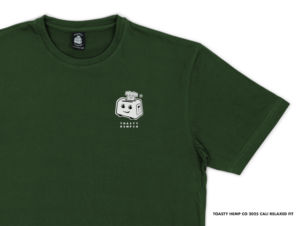
Toasty’s hemp tees keep their shape after wash and wear. Photo courtesy of Toasty Hemp Co.
technology that dominated for years and is still relevant in the wholesale channels, has shifted to more of a home crafter market. Her company, LAT Apparel, will not only test fabrics during the development stages but will include print recommendations and techniques to their customers. “We always try to maximize the amount of print techniques available for our fabrics. For instance, our fleece products are elevated with a 3-end fleece that has a 100-percent cotton face which allows for a smooth decoration surface that most other fleece in the market does not offer,” Oleksik said.
The type of fabric, of course, makes a difference, with DTG being ideal for cotton, and polyester blends better for sublimation and DTF, agreed Mendoza.
Hemp, however, is a new frontier for most decorators, and Zaczynski said that his company is always learning something new, often having to be the being the first to pioneer decorating methods, which he said is both terrifying and exciting.
“For us in hemp, it feels like we will be developing new tee technology in real time in 2025—it’s going to be a huge R&D year. We’ve only begun to scratch the surface with respect to hemp’s potential, and developing the technology to produce unique blends is as important as imagining new designs and silhouettes for this amazing material. Decoration is most definitely a form of art, but for us it’s also very much a science because we’re having to define many of the techniques and standards that we’ll eventually be communicating to our industry partners.”
Threadfast, too, is looking into innovative, eco-friendly treatments that reduce water usage to align with the company’s sustainability goals. “Threadfast also has innovated by creating the only NFC enabled t-shirt in the industry which holds an NFC chip on its sleeve that can be programmed to any digital content the customer needs,” said Mendoza.
What to Expect in the Future with T-shirt Design and Custom Decorating
Toasty Hemp has been working with collaborators in Pakistan to develop a new supply chain for hemp fabrics, as that country has recently legalized the cultivation of industrial hemp.
“For 2025, we are excited about releasing our own takes on classic hemp blends, and also some experimental new blends that the world has never previously seen from hemp,” said Zaczynski.
The desire for sustainability is only going to expand as the years go by. “New laws are also driving companies to adjust their priorities to stay compliant in the regions they are selling in,” said Davis, noting that new laws on the books in some states are outlining the ways in which companies should keep their products out of landfills and are regulating how companies should disclose greenhouse gas emissions. “Because of these things, the delay between the retail and wholesale channels has disappeared.”
Hilary Daninhirsch is an award-winning freelance writer based in Pittsburgh. Her work has been featured in a number of lifestyle and trade magazines. She can be reached at [email protected] or hilarydaninhirsch.journoportfolio.com.
Updated 4/24/25

